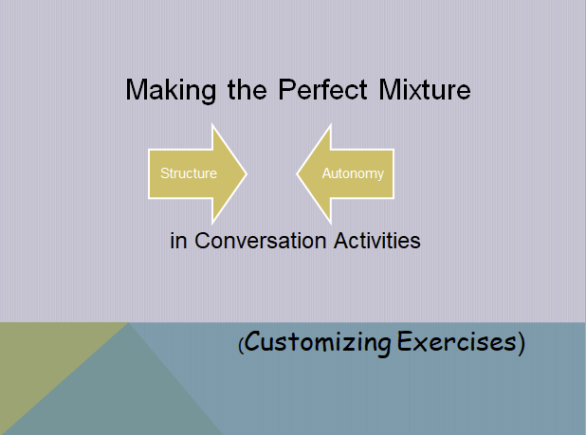
(This posting includes a handout which you are welcome to use with your students.)*
![]() This posting is discussed on my YouTube video: Perfect Mixture Structure and Autonomy
This posting is discussed on my YouTube video: Perfect Mixture Structure and Autonomy
“Ms. Brown, do we really have to do anything we want to do again today?”** Ms. Brown is probably an extreme case of instructors who try to give their students autonomy because they believe students know best what they are interested in.
The chances are that you are from a different culture, different generation and/or different socio-economic group from your students. You probably have a different marital status, different interests and/or different goals. So how can you tap into what will be most stimulating for your students to talk about when they are practicing conversational techniques? In other words, how can you customize the exercise for your current group of students?
A key phrase in the question is “conversational techniques.” Students should be learning techniques that they can apply in conversational situations. Some technique examples are: beginning a conversation, giving understanding responses, clarifying something, politely interrupting someone, rephrasing something, soliciting details, giving opinions, summarizing what was said, ending a conversation.
Let’s say Ms. Brown wants her students to practice giving opinions. To customize the activity, she tells the students to think of topics that are interesting to them, get into groups and tell their opinions. But, without any kind of structure, the students will probably just take turns monologuing, not actually engaging in a conversation.
The “perfect mix” of structure and customizing involves three parts:
Part 1) Introductory exercise
Students are introduced to the technique and briefly work with some examples of how it is used in conversational situations. In other words, they don’t just mindlessly read some sample dialogs.
Part 2) Structured exercise
Using questions or prompts, students practice in pairs/small groups.
Part 3) Customizing exercise
Using Steps 1 and Steps 2 as models, students in pairs write prompts or questions. Then in new groups, they use these student-made items to further practice the technique.
To demonstrate this perfect mix, we’ll look at how Ms. Brown could have made her “giving-opinions” activity more productive and engaging.
The conversational techniques they will practice in this example are;
1) using natural statements to express an opinion;
2) using natural statements to agree;
3) using natural statements to disagree.
Here are samples of Parts 1-4. The link to the downloadable handout is below.
Part 1) Introductory exercise: Students are introduced to the expressions, the technique and briefly work with some examples of how they are used in conversational situations.

This is a model of how they can use the expressions in a natural conversation. Notice that students need to engage with dialogs, not merely read them. (The handout includes four different dialogs like this one.)

Part 2) Structured exercise: Using the questions or prompts, students practice in pairs (Student A / Student B) stating opinions, agreeing and disagreeing using a variety of natural expressions. (Please note: In Step 1, Student A reads the statement and Student B responds. In Step 2, the roles are reversed with Student B making the statement and Student A responding.)
They cannot see each other’s paper.

You will notice that even in this structured exercise, students are given a chance to customize the statement by filling in the blanks.
Part 3) Customizing exercise. In Step 3, Student A and Student B work together. They are given the autonomy to write several “opinion” sentences. This is their chance to write about specific opinions about their classmates, school, town and national/international news.

This is the step that assures that this activity is always up-to-date and appealing to this specific group of students. Often the students make statements that about topics that were completely unknowable to the instructor. Some example of what students have written:
- It seems to me that Anna (classmate) and Tanya (classmate) should find a new apartment.
- Don’t you think that Wang (classmate) and Ngan (classmate) would make a good couple?
Or they write statements about a current event which might not be relevant in the future. For example:
- If feel that the U.S. should accept more refugees?
Part 4) Form new groups.

In Step 4, Student A and Student B separate and join new partners. When doing this step, the students tend to become a lot more animated and the constructive noise level greatly increases, often with a lot of laughing as students are determined to understand each other and to find out their opinions. Because they have learned the structure of a conversation, they don’t just monologue. Instead they truly interact with each other.
If you would like to try out this activity with your students, I’ve attached a handout here: Expressing opinions Expressing opinions
This activity and similar ones come from Pro Lingua Learning–Conversation Strategies
Also, for similar activities that involve structure and autonomy, see my previous postings for Rejoinders and Follow-up Questions. Conversation magic: Two most important conversation techniques (Part 1) and Conversation magic: Two most important techniques. (Part 2)
In this YouTube segment, an instructor, Robin Dubacker, describes using these materials. YouTube Conversation Strategies
David Kehe
*About the free-download materials. During my 40 years of teaching ESL, I have had many colleagues who were very generous with their time, advice and materials. These downloads are my way of paying it forward.
**Drawn from Earl Stevick’s A Way and Ways.